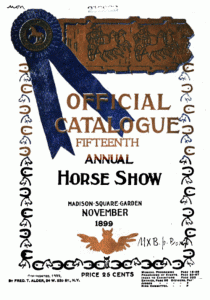
So much has changed since I showed hunters in the 60’s and 70s that I barely recognize the divisions and I definitely don’t identify with many of the fads. But if the 60s and 70s date me… consider the 1897 Madison Square Garden Horse Show. And keep in mind – this was before Caprilli and Chamberlin.
In 1897 classes were for Qualified Hunters or Jumpers. Qualified hunters had been kept for hunting, had hunted for a full year within a year of the show and had a certificate saying so.
The biggest horses were entered in the Heavyweight Hunters where they carried 190 pounds. Horses stood from 16.1-17.1 hh and most of them were 5 – 7 years old. Medium weight Hunters carried 165 -190 pounds, with Lightweight hunters at 165 pounds. Conformation and quality counted 50% and performance over fences counted the other 50%. Thoroughbred hunters had their own class and could be qualified or green.
All the classes awarded prize money. Most gave $200 for first place, $100 for second and $50 for third. I wonder what $200 would equal today?
Ladies hunters carried up to 165 pounds, however they were judged 25% on conformation and quality with 75% to count on performance over fence and manners. Ladies Hunters was the largest class of the non green hunters with 14 entries. Were the ladies all riding side saddle?
There were separate classes for green hunters at each of the weights. A green hunter was a horse who was in his first year of actual hunting. The middleweight green hunter class had 20 entries.
Horses had to be ridden by a member of a recognized hunt in the Corinthian class. Conformation counted 25% and the horses could be qualified or green. This must have been the class to win because it had 40 competitiors.
Jumping classes were open to all horses. And the prize money was not as high. The first class may have been a warm up class because doesn’t list a height and has 46 entries . The second class makes you take notice. It reads: “For the best performance of Hunters or Jumpers over six fences; two at 5 feet, two at 5 feet six inches, and 2 at 6 feet, to carry a minimum weight of 140 pounds.” There were only 9 entries, many of whom were from the Hunter classes.
The next class in the jumper section had 25 entries and it was a test over 6 fences that were 5 feet high.
The final jumping class is called the “High Jump”for which the description is not clear. Would this be the single fence with multiple, closely spaced bars that we’ve seen in period photos? The jump starts at 5 feet and is raised in 6 inch increments until 6’6” is reached. If there is a tie at 6’6” then the judges must consider the form with which the horses have taken their jumps! 7 horses in this class, some of whom were also in hunter classes.
In 1897 there were 13 classes plus a single championship for hunters and jumpers at the National Horse Show in Madison Square Garden. The classes had preliminaries to choose the horses that would compete in the evenings. The format was simple; qualified hunters, ladies hunters, Thoroughbred Hunters, green hunters and jumpers. There were no pre greens, first or 2nd year greens, AO, adult, junior or 3 foot hunters, no equitation, no children’s classes etc. The fence heights were pretty basic and made it clear they were looking for a contest. At 5 feet to 6’6” you’d better bring a horse to this show that could jump.
In 1897 hunters were hunters, hunters were jumpers and jumpers were jumpers……
So what happened to change our competitions? Did the arrival of Caprilli’s method cause horsemen to be more intelligent and humane? Or did the last 100+ years produce a society of riders who lowered their sites and produced a mass product that was palatable and easy? What do you think?

As my children are young, I appreciate the experience my children can have. But I think what today’s format has done turned a show case and a testing tool (showing in an enclosed ring) into the be all and end all. When people won’t show at one of the local schooling shows because the ring is not enclosed, are they actually confidently and in control of their mounts? Are they really riding? I realize that many don’t have a cross country course in their back yard, but to me, if you can’t ride your horse without an enclosure, you’re not truly riding. I appreciate the trappings of modern riding, such as the variety of classes and the crest release, but the problem is they are no longer way stops on a journey but the destination itself.